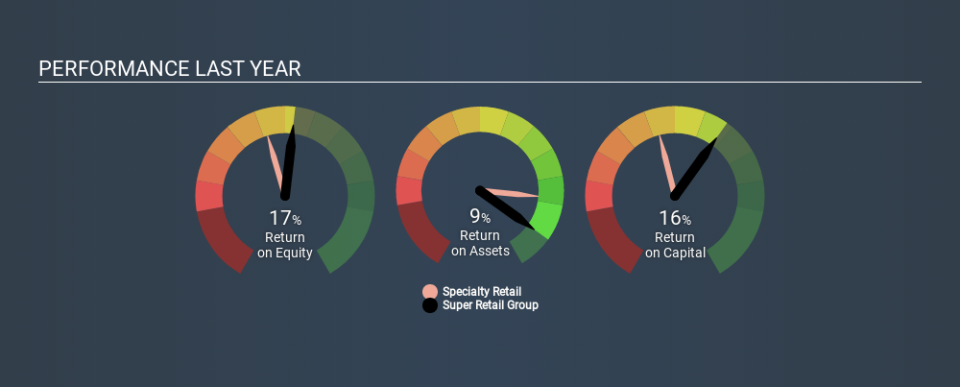Is There More To Super Retail Group Limited (ASX:SUL) Than Its 16% Returns On Capital?

Today we'll evaluate Super Retail Group Limited (ASX:SUL) to determine whether it could have potential as an investment idea. Specifically, we'll consider its Return On Capital Employed (ROCE), since that will give us an insight into how efficiently the business can generate profits from the capital it requires.
First of all, we'll work out how to calculate ROCE. Next, we'll compare it to others in its industry. And finally, we'll look at how its current liabilities are impacting its ROCE.
Return On Capital Employed (ROCE): What is it?
ROCE is a measure of a company's yearly pre-tax profit (its return), relative to the capital employed in the business. In general, businesses with a higher ROCE are usually better quality. In brief, it is a useful tool, but it is not without drawbacks. Renowned investment researcher Michael Mauboussin has suggested that a high ROCE can indicate that 'one dollar invested in the company generates value of more than one dollar'.
How Do You Calculate Return On Capital Employed?
Analysts use this formula to calculate return on capital employed:
Return on Capital Employed = Earnings Before Interest and Tax (EBIT) ÷ (Total Assets - Current Liabilities)
Or for Super Retail Group:
0.16 = AU$212m ÷ (AU$1.8b - AU$480m) (Based on the trailing twelve months to June 2019.)
Therefore, Super Retail Group has an ROCE of 16%.
Check out our latest analysis for Super Retail Group
Is Super Retail Group's ROCE Good?
ROCE can be useful when making comparisons, such as between similar companies. It appears that Super Retail Group's ROCE is fairly close to the Specialty Retail industry average of 15%. Separate from Super Retail Group's performance relative to its industry, its ROCE in absolute terms looks satisfactory, and it may be worth researching in more depth.
In our analysis, Super Retail Group's ROCE appears to be 16%, compared to 3 years ago, when its ROCE was 10%. This makes us wonder if the company is improving. You can click on the image below to see (in greater detail) how Super Retail Group's past growth compares to other companies.
When considering this metric, keep in mind that it is backwards looking, and not necessarily predictive. ROCE can be misleading for companies in cyclical industries, with returns looking impressive during the boom times, but very weak during the busts. ROCE is only a point-in-time measure. Future performance is what matters, and you can see analyst predictions in our free report on analyst forecasts for the company.
Do Super Retail Group's Current Liabilities Skew Its ROCE?
Current liabilities include invoices, such as supplier payments, short-term debt, or a tax bill, that need to be paid within 12 months. Due to the way ROCE is calculated, a high level of current liabilities makes a company look as though it has less capital employed, and thus can (sometimes unfairly) boost the ROCE. To counter this, investors can check if a company has high current liabilities relative to total assets.
Super Retail Group has current liabilities of AU$480m and total assets of AU$1.8b. Therefore its current liabilities are equivalent to approximately 27% of its total assets. Current liabilities are minimal, limiting the impact on ROCE.
What We Can Learn From Super Retail Group's ROCE
Overall, Super Retail Group has a decent ROCE and could be worthy of further research. There might be better investments than Super Retail Group out there, but you will have to work hard to find them . These promising businesses with rapidly growing earnings might be right up your alley.
If you like to buy stocks alongside management, then you might just love this free list of companies. (Hint: insiders have been buying them).
If you spot an error that warrants correction, please contact the editor at editorial-team@simplywallst.com. This article by Simply Wall St is general in nature. It does not constitute a recommendation to buy or sell any stock, and does not take account of your objectives, or your financial situation. Simply Wall St has no position in the stocks mentioned.
We aim to bring you long-term focused research analysis driven by fundamental data. Note that our analysis may not factor in the latest price-sensitive company announcements or qualitative material. Thank you for reading.


